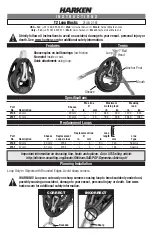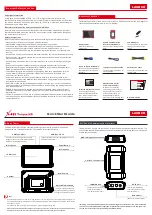
NOTE:
Carefully review and follow all
Risks and Precautions
,
Safety Information
and
Contraindications
(and all other aspects of this guide) before placing patient.
1. Install
First Step
Select unit.
• If using FSS unit as an overlay, typical for FSS Classic, FSS Cirrus and FSS Air Rail, retain
existing mattress.
• If using FSS unit as a mattress replacement system (MRS) typical for FSS Excel, remove
existing mattress.
2. Position FSS unit on bed frame with hose set at patient’s left foot of bed.
• Place therapy control unit on foot board.
• Connect air hoses to therapy control unit and MRS.
3. Install
First Step
Select Fabric Cover Sheet (optional for
First Step
Cirrus).
First Step
Cirrus
may be used with standard hospital cotton sheets.
4. Plug therapy control unit into wall outlet and press power switch to activate.
5. Press Instaflate™ to inflate cushions and create a firm surface for patient transfer.
6. Ensure wheel brakes and wheel steering are locked.
7. Transfer patient following all applicable safety rules and institution protocols.
8. Center patient on FSS surface. Patient’s sacrum should be centered head-foot on seat section
cushion.
9. Raise and lock side rails (If used, refer to
Risks and Precautions
and
Safety Information
on
side rail / patient restraints).
10. Deactivate
Instaflate
and press the pressure adjust button.
• Use patient’s height / weight for first time placements.
• Use Manual method to make adjustments to sectional pressures.
11. Lower bed height to lowest level. Verify patient comfort.
12. Activate warmer and adjust temperature for patient comfort, if desired.
13. Carefully re-review and follow all
Safety Information
,
Risks and Precautions
before leaving
patient unattended.
1. Grasp hose set, lift up on quick release lever.
2. Pull hose set away from therapy control unit.
3. Level bed and lower side rails.
4. Place backboard under patient.
5. Begin CPR.
NOTE
: Patient’s body weight and the CPR process
will deflate cushions and air base.
6. After CPR is completed and patient is clinically stable:
• Connect hose set to therapy control unit.
• Return side rails, restraints and other accessories (if used; refer
to
Safety Information
) to their original configurations.
• Restore surface to previous air pressure and warmer (if used)
settings.
PATIENT PLACEMENT
CPR
CONTROL PANEL
SAFETY INFORMATION
See also CONTRAINDICATIONS and RISKS and PRECAUTIONS
Quick Release
Lever
SEAT DEFLATE
Assist patient exit and
bedpan placement by
lowering pressure in
body section
INSTAFLATE
Assist in patient
transfer and bathing by
increasing pressure
throughout the overlay.
HOME DISPLAY
Allows comfort control
for up to 25% uniform
pressure adjustment.
PRESSURE ADJUST
Allows caregiver to
adjust pressure in both
HT / WT and Manual
modes as shown below.
WARMER ADJUST
Allows three optional levels
of comforting warmth
Use HT / WT mode for first time
patient placements
Press Manual button to make additional
adjustments to individual
Head, Body and Leg sections
PRESSURE ADJUST
HT/WT EXIT MANUAL
PRESSURE ADJUST
Press Pressure Adjust button and
select HT / WT mode to adjust air
pressure according to patient’s height
and weight.
INSTAFLATE
ON/OFF
SOFT
FIRM
SEAT
DEFLATE
ON/OFF
PRESSURE
ADJUST
WARMER
ADJUST
Bed Frame
- Always use a standard health care bed frame with side rails and any other
safeguards or protocols that may be appropriate. Frame and side rails (if used - see Risks
and Precautions) must be properly sized to eliminate any gaps that might entrap a patient’s
head or body.
Brakes
- Caster brakes should always be locked once the bed is in position. Verify wheels
are locked before any patient transfer to or from the bed.
Bed Height
- To minimize the risk of falls or injury the bed should always be in the lowest
position when the patient is unattended.
Side Rails / Patient Restraints
- Whether and how to use side rails or restraints is a
decision that should be based on each patient’s needs and should be made by the patient
and the patient’s family, physician and caregivers, with facility protocols in mind. Caregivers
should assess risks and benefits of side rail / restraint use (including entrapment and patient
falls from bed) in conjunction with individual patient needs, and should discuss use or
non-use with patient and / or family. Consider not only the clinical and other needs of the
patient but also the risks of fatal or serious injury from falling out of bed and from patient
entrapment in or around the side rails, restraints or other accessories. In the US, for a
description of entrapment hazards, vulnerable patient profile and guidance to further reduce
entrapment risks, refer to FDA’s Hospital Bed System Dimensional and Assessment
Guidance To Reduce Entrapment. Outside the US, consult the local competent authority or
government agency for Medical Device Safety for specific local guidance. Consult a
caregiver and carefully consider the use of bolsters, positioning aids or floor pads, especially
with confused, restless or agitated patients. It is recommended that side rails (if used) be
locked in the full upright position when the patient is unattended. Make sure a capable
patient knows how to get out of bed safely (and, if necessary, how to release the side rails) in
case of fire or other emergency. Monitor patients frequently to guard against patient
entrapment.
When selecting a mattress and overlay combination or MRS, ensure the distance between
top of side rails (if used) and patient surface (without compression) is at least 8.66 in (220
mm) to help prevent inadvertent bed exit or falls. Consider individual patient size, position
(relative to the top of the side rail) and patient condition in assessing fall risk.
Skin Care
- Monitor skin conditions regularly, especially at bony prominences and areas
where moisture or incontinence may occur or collect, and consider adjunct or alternative
therapies for high acuity patients. Early intervention may be essential to preventing serious
skin breakdown.
Fluids
- Avoid spilling fluids on the therapy control unit. If spills do occur, unplug the unit,
clean fluid from the bed and the therapy control unit wearing rubber gloves to avoid any
possibility of shock. Once fluid is removed, check operation of components in area of spill.
Fluids remaining on controls can cause corrosion, which may cause components to fail or
operate erratically, possibly producing potential hazards for patient and caregivers.
Lock-Outs
- The lock-out feature on the therapy control unit should be used at the caregiv-
er’s discretion to ensure against unintentional or unauthorized tampering with unit settings.
Avoid Fire Hazards
- To minimize risk of fire, connect the unit’s power cord directly to the
wall-mounted outlet. Do not use extension cords or multiple outlet strips.
No Smoking in Bed
- Smoking in bed can be dangerous. To avoid the risk of fire, smoking in
bed should never be allowed.
Tobacco Smoke
- If routine laundering and cleaning procedures as described in the
Preventative Maintenance section of the Maintenance chapter of the First Step Select MRS
Maintenance Manual are not followed, tobacco smoke build-up may conceivably reduce the
amount of air flow through the product. Severe air restrictions (whatever the source) may
cause the therapy control unit to overheat and automatically deactivate.
Power Cord
- Ensure power cord is kept free from all pinch points and moving parts and is
not trapped under casters. Improper handling of the power cord can cause damage to the
cord, which may possibly produce risk of fire or electrical shock.
General Protocols
- Follow all applicable safety rules and institution protocols concerning
patient and caregiver safety.




















